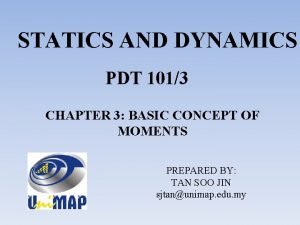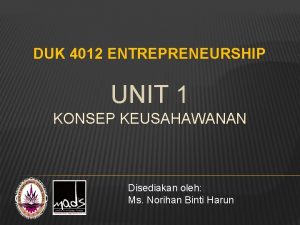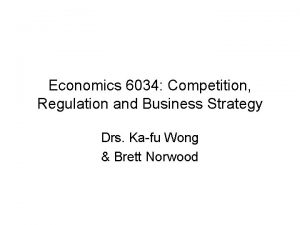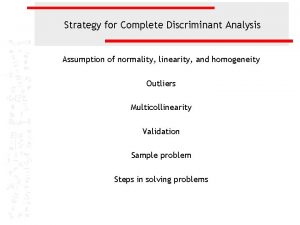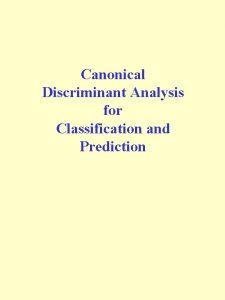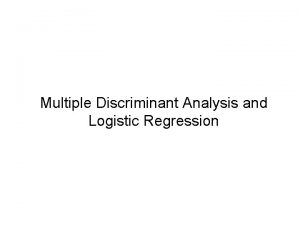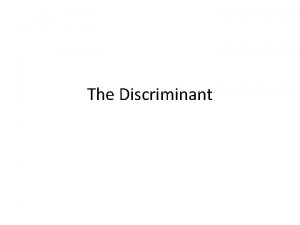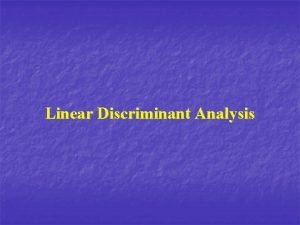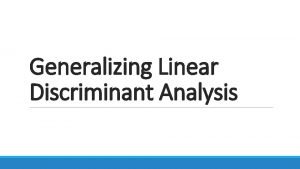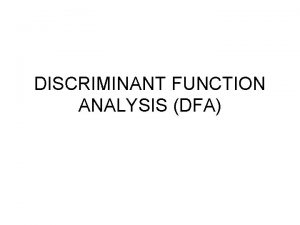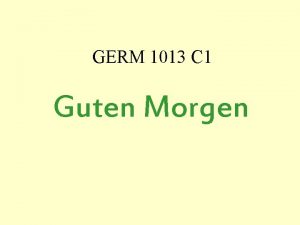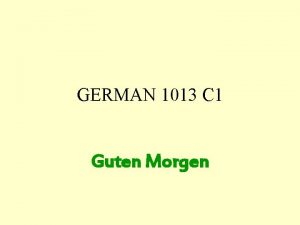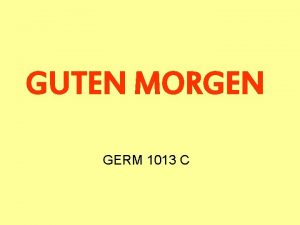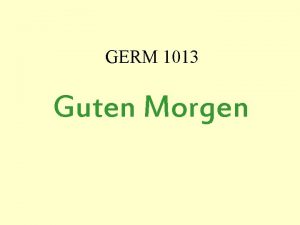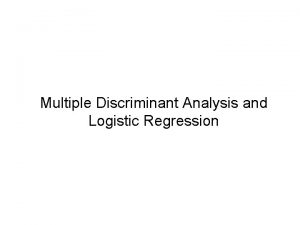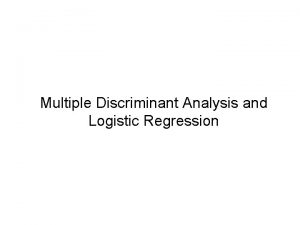DRS 1013 Discriminant Analysis Discriminant Analysis Overview n

















- Slides: 17

D/RS 1013 Discriminant Analysis

Discriminant Analysis Overview n n multivariate extension of the one-way ANOVA looks at differences between 2 or more groups goal is to discriminate between groups considers several predictor variables simultaneously

Discriminant - Overview n n n provides a way to describe differences between groups in simple terms. removes the redundancy among large numbers of variables by combining into a smaller number of Discriminant functions can classify cases to groups when their group membership is unknown

Overview (cont. ) n n tests the significance of differences between two or more groups examines several predictor variables simultaneously construct linear combination of these variables, forming a single composite variable called a discriminant function basically MANOVA flipped upside down

Discriminant parallels with MANOVA and Regression n Discriminant works the other way, predicting group membership by some kind of scores The discriminant function takes the form: D = d 1 z 1 + d 2 z 2 +. . . + dpzp

Discriminant functions n Di = d 1 z 1 + d 2 z 2 +. . . + dpzp – where, D = scores on the discriminant function – d 1 - dp = discriminant function weighting coefficients for each of p predictor variables – z 1 - zp = standardized scores on the original p variables

Unstandardized Functions n n even more like regression equation Di = a + d 1 x 1 + d 2 x 2 +. . . + dpxp –a = the discriminant function constant – d 1 - dp = discriminant function weighting coefficients for each of p predictor variables – x 1 - xp = raw scores on the original p variables

Forming discriminant functions n n n discriminant function is formed to maximize the F value associated with the D F = bg variance on D / wg variance on D provides a function with the greatest discriminating power.

Functions beyond the first n n n first function is one of many combinations of the p original predictor variables. # of useful functions is p (# of original variables) or k-1 (k=# of groups being considered), whichever is smaller. later functions maximize the separation between groups and are orthogonal with the preceding functions.

First discriminant function (3 gps) Separates group 1 from groups 2 & 3

Second function (3 gps) Separates group 3 from groups 1 & 2

Both functions together Orthogonal = uncorrelated

Confusion Matrix n n n assign cases to groups based on their discriminant function scores assignments compared with actual group memberships confusion matrix gives both overall accuracy of classification and the relative frequencies of various types of misclassification

Confusion matrix: example S our proportion correct is (43 + 39)/100=. 82 S by chance alone we would end up with. 50 correct S if we evenly divided our group assignments S between A & B half in each group correct by chance S can consider prior probabilities, if known

Cross Validation n hold back some of the data to test the model that emerges gives good idea of the kind of predictive accuracy we can expect for another sample small samples and several variables unlikely to replicate across samples

Classification Functions n n n weights and constants used to calculate scores for each case as many scores as there are groups for each case assign to group that the case has the highest classification function score for

Assumptions n n n assumes that all predictors follow a multivariate normal distribution test is robust with respect to normality, in practice, lack of normality doesn't make much of a difference especially with large n and moderate number of predictors
 Meredith nelson dan neck 1982
Meredith nelson dan neck 1982 1013 chapter
1013 chapter Konsep keusahawanan
Konsep keusahawanan Amalgaamafscheider
Amalgaamafscheider Pendapat dari drs. wasty soemanto, m.pd
Pendapat dari drs. wasty soemanto, m.pd My drs temple
My drs temple Cisco drs backup
Cisco drs backup Drs koh and trory
Drs koh and trory Drs.wa.gov/oaa
Drs.wa.gov/oaa Drs atypique
Drs atypique Drs
Drs Drs atypique
Drs atypique Temple university drs
Temple university drs Drs hardwarezone
Drs hardwarezone Drs abcdefg
Drs abcdefg Discriminant analysis assumptions
Discriminant analysis assumptions Discriminant analysis spss
Discriminant analysis spss Logistic regression and discriminant analysis
Logistic regression and discriminant analysis

